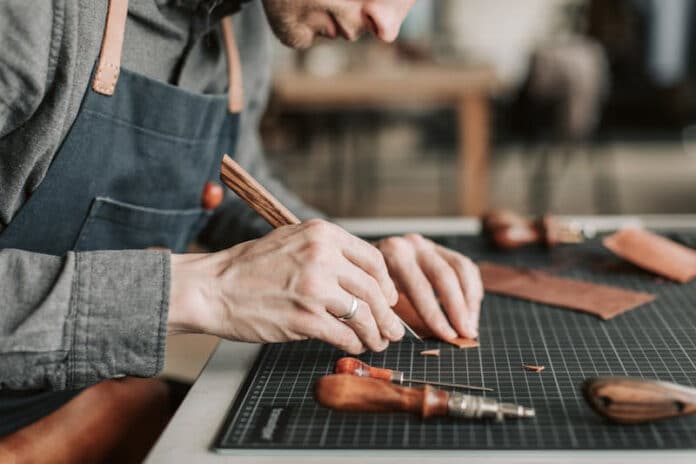If you’ve ever struggled to get clean cuts, smooth stitches, or crisp tooling, chances are you’re making one of these common mistakes.
Leather doesn’t forgive. It stretches when it shouldn’t, resists when you want it to cooperate, and punishes mistakes without hesitation. And the tools? They’re not just accessories; they’re an extension of your hands. If you don’t use them right, they will fight back.
Most beginners think leather working is just cutting, stitching, and maybe a little stamping for decoration. But the truth? It’s about control. Control over tools, control over materials, and control over technique. The right setup changes everything, and professional leather tools give you that edge, turning frustration into precision.
Cheap Tools Lead to Expensive Problems
It’s tempting. That budget-friendly leather working kit with 20 different tools for the price of one? Feels like a great deal—until you actually use it.
Here’s what happens:
- The knife dulls after a few cuts, making every slice a battle.
- The awl bends or snaps, forcing you to press too hard and stretch the leather instead of piercing it.
- The mallet vibrates instead of delivering a clean strike, leaving you with uneven impressions.
Cheap tools don’t just make your work harder. They teach bad habits. A dull knife forces you to saw instead of slice, leading to jagged edges. A flimsy groover makes it impossible to stitch straight.
The fix? Start with fewer, better tools. A sharp blade, a sturdy awl, and a solid mallet will take you further than a box of unreliable knockoffs.
The Wrong Blade Ruins the Cut
Cutting leather isn’t the same as slicing paper. Leather fights back. If you don’t use the right blade, you’ll end up dragging, tearing, or bruising the material.
Not all knives are equal:
- Utility knives are great for straight cuts but struggle with curves.
- Round knives glide through thick leather but require skill.
- Skiving knives are perfect for thinning edges without damaging the surface.
And sharpening? Non-negotiable. A razor-sharp knife glides through leather. A dull one forces you to push harder, increasing the risk of slips, uneven cuts, and even injury.
Stitching Without a Groove Looks Sloppy
Hand-stitched leather is a mark of craftsmanship. But beginners often skip a crucial step: the stitching groove.
Without it, stitches look uneven, thread wears down faster, and the finished product lacks that polished, professional touch. A stitching groove guides your needle, ensuring perfect spacing and helping thread sit flush with the surface.
Think of it like drawing a line before cutting—it keeps things straight and prevents guesswork.
Not Every Mallet Works for Leather
Stamping, punching, and setting rivets all require force. But not just any force—the right kind.
Beginners often grab whatever hammer is lying around, thinking all strikes are equal. They’re not.
- Wood and poly mallets absorb shock, preventing bounce.
- Rawhide mauls provide controlled force without damaging stamps.
- Metal hammers? A terrible idea unless you enjoy dented tools and regret.
A good mallet isn’t just about power. It’s about precision. The right strike makes stamping crisp and clean, while the wrong one leaves uneven impressions.
The Wrong Awl Makes Stitching a Nightmare
An awl seems simple—it pokes holes, right? But there’s a huge difference between a well-made awl and a cheap one.
A dull awl forces you to struggle, leaving uneven holes. A round awl doesn’t create that signature slanted stitch. And if the awl is too thick? It stretches the leather instead of cutting it, making stitches look messy and uneven.
For clean, professional stitches, use a diamond-point awl. It creates precise, angled cuts that allow thread to pass through without distorting the leather.
Burnishing Isn’t Optional
Raw leather edges look unfinished. Professionals take the time to smooth and polish them into sleek, rounded edges. That’s burnishing, and it’s one of the easiest ways to separate amateur work from master craftsmanship.
But burnishing isn’t just about rubbing an edge with a slicker. Beginners often get it wrong by skipping key details:
- Friction matters. Steady pressure generates heat, allowing fibers to blend smoothly.
- Water alone isn’t enough. Some leathers need beeswax or gum tragacanth for a sealed, polished finish.
- Skipping this step is obvious. A rough edge stands out—even on an otherwise flawless piece.
Burnishing requires patience, but it’s worth every second. A well-finished edge elevates even the simplest project.
Conclusion
Leather working isn’t just about having tools. It’s about knowing how to use them.
The wrong blade, the wrong mallet, or the wrong technique can make the craft frustrating. But when you invest in good tools, sharpen your knives, and take the time to do things right, leather working transforms from struggle to satisfaction.
Master the tools, and everything else follows.












